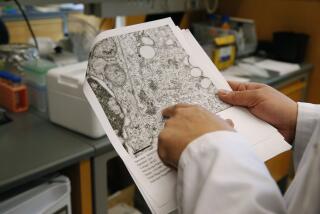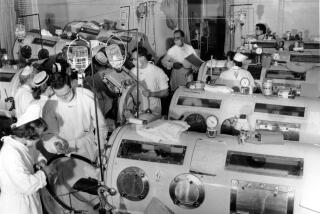Her toddler suddenly paralyzed, mother tries to solve a vexing medical mystery

Lucian Olivera suffers from acute flaccid myelitis, which causes polio-like symptoms.
- Share via
Erin Olivera waited weeks for doctors to tell her why her youngest son was paralyzed.
Ten-month-old Lucian had started crawling oddly — his left leg dragging behind his right — and soon was unable to lift his head, following Erin only with his eyes.
She took him to a hospital in Los Angeles, but doctors there didn’t know how to treat what they saw.
Lucian’s legs felt soft as jelly and he couldn’t move them. His breathing became rapid. The left side of his smile drooped as his muscles weakened.
Physicians ran test after test, and Erin began spending her nights on a hospital room couch. After Lucian fell asleep, during her only minutes alone between working and visiting her three other kids, she cried.
A terrifying reality was taking hold: Doctors wouldn’t be able to give her a diagnosis for her paralyzed child.
How can I make a decision for him when I don’t even know what’s wrong?
— Erin Olivera
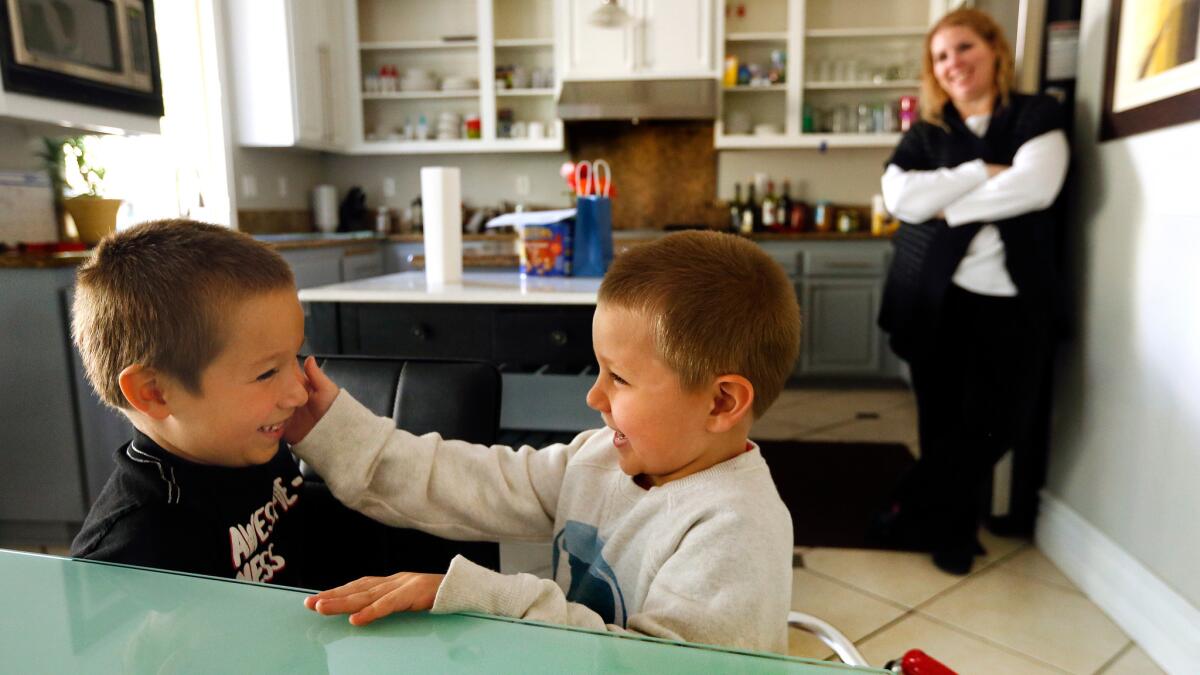
“How can I make a decision for him when I don’t even know what’s wrong?” she said. “What can I do to help him?”
So one morning in July of 2012, Erin lifted Lucian out of his hospital bed, his body limp and heavy. She rested his cheek on her shoulder, the way he liked to be held since he’d become weak.
Erin returned home to Ventura County with a child she thought might never learn to walk.
In the years since, hundreds of children across the country have shown up at hospitals unable to move their arms or legs. Dozens of kids have become paralyzed in the past few months alone.
They suffer from a mysterious illness that continues to alarm and puzzle scientists. This kind of sudden and devastating paralysis hasn’t been widespread since the days of polio. Lucian, one of the disease’s earliest victims, set off a hunt among doctors to discover its cause.
::
Before Lucian got sick, he liked to sit on the floor in the kitchen of his home in Moorpark, his small hands pressed against the glass door to the backyard as he tried to stand. He’d roll around, babbling at the dogs outside.
The child Erin brought home from the hospital didn’t have enough strength to crawl and couldn’t always sit up on his own.
On his first birthday, three weeks after he came home, Erin and her husband Israel propped Lucian up with pillows in a high chair. He giggled as he smeared red frosting on his bare chest and in his blonde hair.
After the kids went to bed in the evenings, Erin and Israel would whisper about Lou-Lou, as they called him. When Erin was pregnant, the couple had decided Lucian would be their last child. They wanted to save money, perhaps take a family vacation. Erin would focus on graduating from nursing school.
Now the future felt upended by questions about their youngest son — whether he’d ever be able to drive a car, get married, have kids.
They took him to more doctors, but that failed to bring a diagnosis, let alone a treatment.
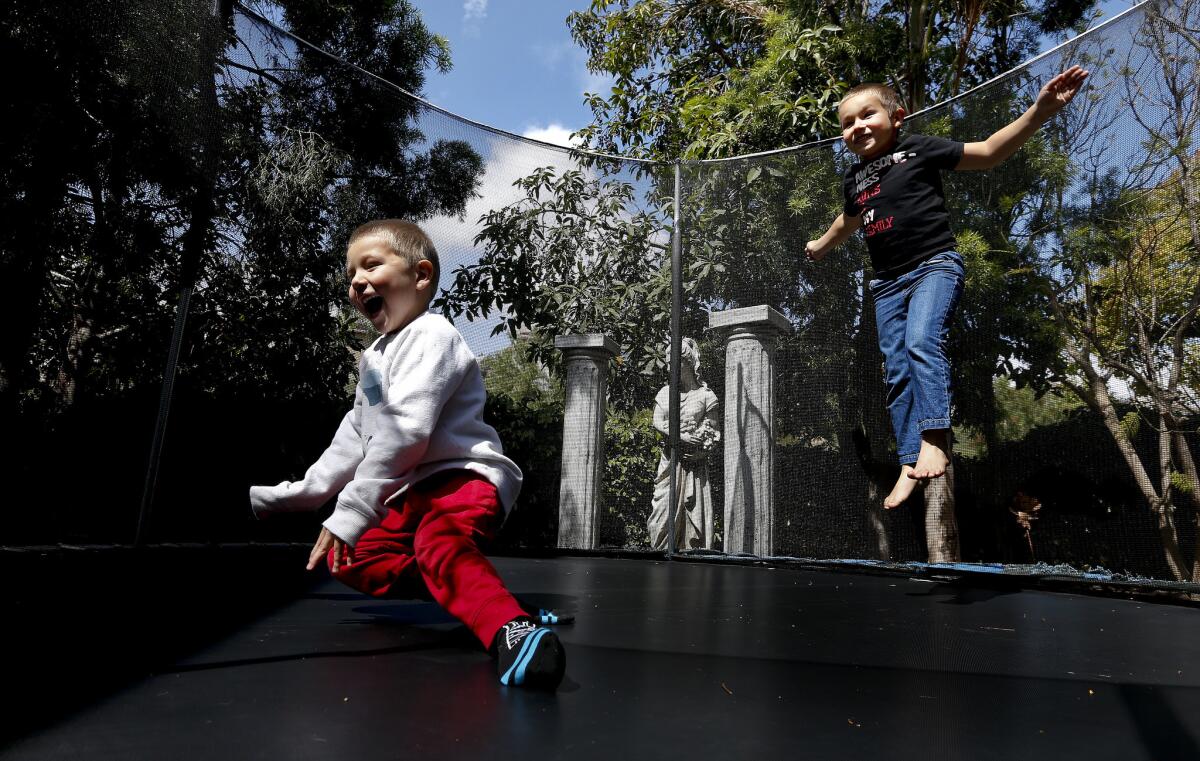
Through months of physical therapy, Lucian eventually regained strength in most of his limbs, but still couldn’t move his left leg at all. When he crawled, it dragged behind.
Desperate, Erin resorted to endless Internet searches looking for clues about her son’s condition.
Then one day, she came across an article online about a dozen paralyzed kids. She immediately thought of Lucian.
The article mentioned Dr. Keith Van Haren, a Stanford University child neurologist who had diagnosed many of the other cases.
She called him.
::
Around the time Lucian first got sick in 2012, Van Haren was flummoxed by a young girl who’d just shown up at his clinic at Stanford.
The 3-year-old had been at home recovering from a bad cold when she suddenly couldn’t move her arm. Weeks later, it still hung from her body like dead weight, flopping wildly when she walked.
The paralysis struck Van Haren as unusual.
Doctors had been treating her for an autoimmune disease, as if her body were wrongly attacking its own cells. But if that were the case, her arm wouldn’t be so limp nor would the paralysis be so limited to one spot; Van Haren would expect other parts of her body also to be somewhat weak.
This, Van Haren thought, looked more like the most infamous cause of paralysis: polio. But it was eradicated so long ago in the United States that most doctors here have never seen a case.
“We know about it through history books,” said Van Haren, then just two years out of training.
The girl had been vaccinated against polio. Van Haren didn’t know what to tell her parents.
When he contacted California’s health department about the odd case, he learned that scientists there had already developed a hunch.
A handful of physicians had seen patients with similar symptoms and asked Dr. Carol Glaser to test them for polio.
“I thought, ‘Well that’s crazy. We don’t have polio here,” said Glaser, then head of the encephalitis and special investigations section at the California Department of Public Health.
Glaser quickly determined the patients weren’t suffering from polio. She also tested for pathogens that can sometimes cause such paralysis, including West Nile virus. All negative.
Then she decided to check for other viruses in the same family as poliovirus, known as enterovirus. And in some of the paralyzed patients, she found a possible culprit: enterovirus D-68.
NEWSLETTER: Get the day’s top headlines from Times Editor Davan Maharaj »
Enterovirus D-68 was incredibly rare, almost never seen after it was first discovered in 1962 in four California children who had pneumonia. Though a cousin of poliovirus, it was only supposed to cause a runny nose and cough.
Van Haren had never heard of it.
Glaser asked Van Haren to consult for the health department, and together they watched for more paralysis cases. Their findings were preliminary, but what if they were accurate? What if there were an outbreak?
::
In the middle of the night, Erin sped past crop fields and cattle ranches on the 5 Freeway, headed north to Stanford. Israel sat next to her in the passenger seat, Lucian asleep in the back.
Erin had found some peace from visiting a polio survivors group at a senior center. The survivors, who reminded her of Lucian, told her they’d lived full, happy lives. Don’t limit us, they’d said.
Still, Erin showed up for a 10 a.m. appointment with Van Haren hoping for a chance of full recovery.
“What happened to your forehead?” asked Lucian, as Van Haren entered the exam room.
Van Haren explained to Lucian, now 2-years-old, that he had a birthmark.
“Does it cause you pain?” Lucian asked.
Van Haren said it didn’t, and told Erin and Israel that the question bothered him. Erin thought her son had insulted the doctor.
But Van Haren explained that he was sorry that that was Lucian’s first question. That meant, he said, that Lucian knew pain.
Van Haren began to examine Lucian’s leg.
It was 2014, two years since Van Haren first treated the young girl with the paralyzed arm.
By now Van Haren, who himself had small children, had grown accustomed to identifying the unique paralysis and relaying the tragic verdict.
One, two, three or four limbs paralyzed. Sudden onset. No cognitive changes.
Lucian fit the bill.
Within minutes, Van Haren delivered the diagnosis: polio-like paralysis likely caused by enterovirus D-68.
Erin’s nose turned red like it does when she tears up.
Van Haren told her there were other children like Lucian, and that doctors were learning more about the disease every day.
He said Lucian should continue physical therapy, but there was no cure. Chances were Lucian would never move his left leg.
As they headed back home, Erin, who was driving, waited for Lucian to fall asleep in the backseat. Then she started to cry.
::
After Erin and Israel returned home with Lucian’s diagnosis, the mystery paralysis began to spread.
In late summer of 2014, enterovirus D-68 started sending kids struggling to breathe to emergency rooms around the country. News reports called it a rare, cold-causing virus, a danger to children with asthma.
But then an 11-year-old boy in Texas with a seemingly normal fever lost the ability to walk and move his right arm.
A 17-year-old girl in Santa Barbara experienced severe neck pain at her birthday party and ended up in the hospital, paralyzed from the neck down.
In Oregon, a 13-year-old boy’s diaphragm stopped working, so he needed a ventilator to breathe. He was completely paralyzed, able only to wiggle his toes and his right hand.
Whatever was happening to these children was “pretty much, literally, exactly, what polio did,” said Dr. Jean-Baptiste Le Pichon, a child neurologist who treated four such patients in 2014 at Children’s Mercy Hospital in Kansas City, Mo.
Glaser watched from California as the numbers of paralyzed kids grew. She became horrified that her theory about enterovirus D-68 might be correct.
That October, Van Haren spoke at a national meeting of child neurologists. He asked 300 specialists how many of them had seen these kinds of paralysis cases in the past few months.
“More than half the hands in the room went up,” he recalled.
Doctors coined a name for the phenomenon: acute flaccid myelitis. “Acute flaccid” for the sudden and total paralysis and “myelitis” for an injury to part of the spinal cord involved in muscle movement, called the gray matter.
Between August 2014 and January 2015, 120 children in 34 states were diagnosed with acute flaccid myelitis, according to federal health officials. The median patient age was 7.
Physicians are still baffled that no one had noticed the possible risk of paralysis before.
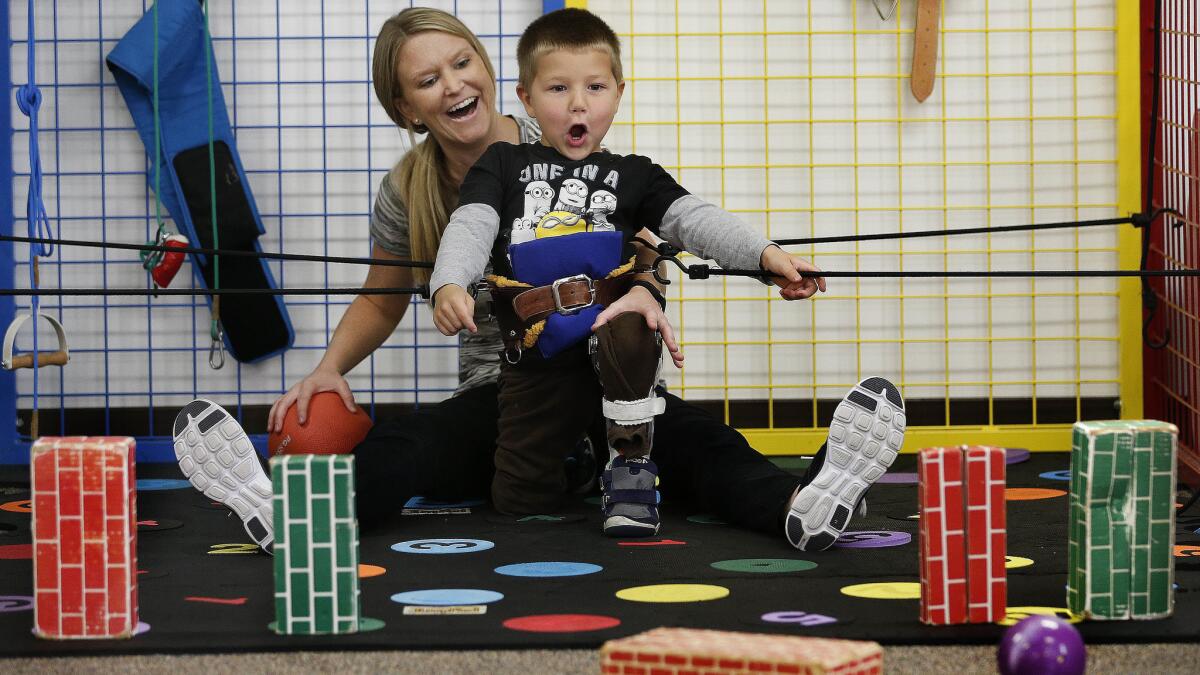
Erin hoped the new cases would lead to a cure for her son.
But doctors say that though the disabled children can regain strength in some limbs, there’s usually also some paralysis that cannot be reversed — just like with polio.
Scientists think a virus travels to the spinal cord and damages motor function there, irreversibly.
::
Holding the red handles of his walker, Lucian, 5, jumped up and down and told his brother Nikolas to put on his shoes faster. Kids shout, skee balls thump, arcade games cha-ching.
The boys stood on either side of Erin, pulling at her skirt as she talked to the cashier at Chuck E. Cheese’s. “We need tokens! We need tokens!” they chanted.
A year apart in age, Nikolas and Lucian share the same round, bright eyes and blondish hair. Sometimes they try to pass for twins.
Four years after being hospitalized, Lucian wears braces on both legs — the one on his left leg decorated with Spider-Man designs, the right with skulls. When he uses his wheeled walker, he steps with his right leg, pulling his left behind him. His left leg is still completely paralyzed.
Israel stopped working so he could take care of Lucian. Erin often works 64 hours a week as a hospital psychiatric nurse so the couple can pay their bills.
Erin and Israel abandoned their 10-year plan, as well as dreams of buying their oldest son a car when he turned 16, or a vacation home. Their priorities have instead become much more short-term.
Over the summer, the biggest one was kindergarten.
They knew Lucian would do fine academically, he often seemed precociously intuitive and observant.
But would he use a walker or a wheelchair? Would he be in special needs classes? Would they be able to potty-train him on time? Would he need an aide in the classroom? And the most agonizing: would he fit in?
Erin had seen Lucian sitting alone at playgrounds, watching other kids run around. Erin and Israel stayed up at night worrying about how to deal with bullies, joking about “who’s going to bail which one of us out of jail first,” she said.
Lucian is too young to fully grasp his disability. He knows he can’t run or walk on his own, and that makes him unlike other kids. And when he meets new people, he squints his eyes as if he’s trying to read their face, to understand them — how they’ll react to him.
But if you ask Lucian why he uses a walker, he’ll blame his older sister, who fell on and fractured his leg two years ago. His parents have repeatedly told him that isn’t why he’s paralyzed, but he doesn’t seem to hear.
That half-understanding sometimes protects Lucian from the pain of his injury’s permanence. But it also means each day could bring a new reckoning of his life’s limitations.
A few months ago, Lucian asked his parents for an injection. “It’ll fix my leg and it’ll be like Niko’s,” he said, using his pet name for Nikolas.
Erin told Lucian what she had many times before: his disability is permanent, there’s no miracle treatment. His leg would get stronger over time, with exercise, but it would never be like his brother’s.
Lucian angrily pursed his lips and his eyebrows tensed. He went silent.
::
Between June and August this year, another 30 children nationwide became paralyzed, and scientists still don’t know why.
Dr. Manisha Patel, who heads the acute flaccid myelitis team for the U.S. Centers for Disease Control and Prevention, said the agency is concerned by the increase and its resemblance to 2014. Experts think case numbers for September and October will be even higher.
But there’s not much public health officials can do, because the paralysis officially remains a medical mystery.
Many suspect that enterovirus D-68 — which gave hundreds of people a severe cold in 2014 — also caused the paralysis outbreak that year. Some of the paralyzed children had enterovirus D-68 in their system, and researchers have found that injecting mice with enterovirus D-68 paralyzes them.
But to confirm the link, doctors need to find enterovirus D-68 in the paralyzed children’s cerebrospinal fluid, to show that the virus traveled to the spinal cord and created the injury there — which they haven’t yet.
And physicians are still baffled that no one had noticed the possible risk of paralysis before.
Some think there hadn’t ever been enough cases of enterovirus D-68 to unmask the horrifying side effect; only 26 people tested positive for the virus in 36 years. Another possibility is that enterovirus D-68 recently mutated to become more likely to paralyze those infected.
For now, experts say that enterovirus D-68 isn’t enough of a threat to make a vaccine and that many people now have immunity to the virus from the 2014 outbreak. Plus, it will probably mutate again, rendering a vaccine that protects against the current strain useless.
“You kind of hold your breath and hope it doesn’t get worse,” Van Haren said.
::
Lucian had been too excited about his first day of kindergarten to eat his Cheerios in the morning, instead unzipping his backpack and removing folders and papers.
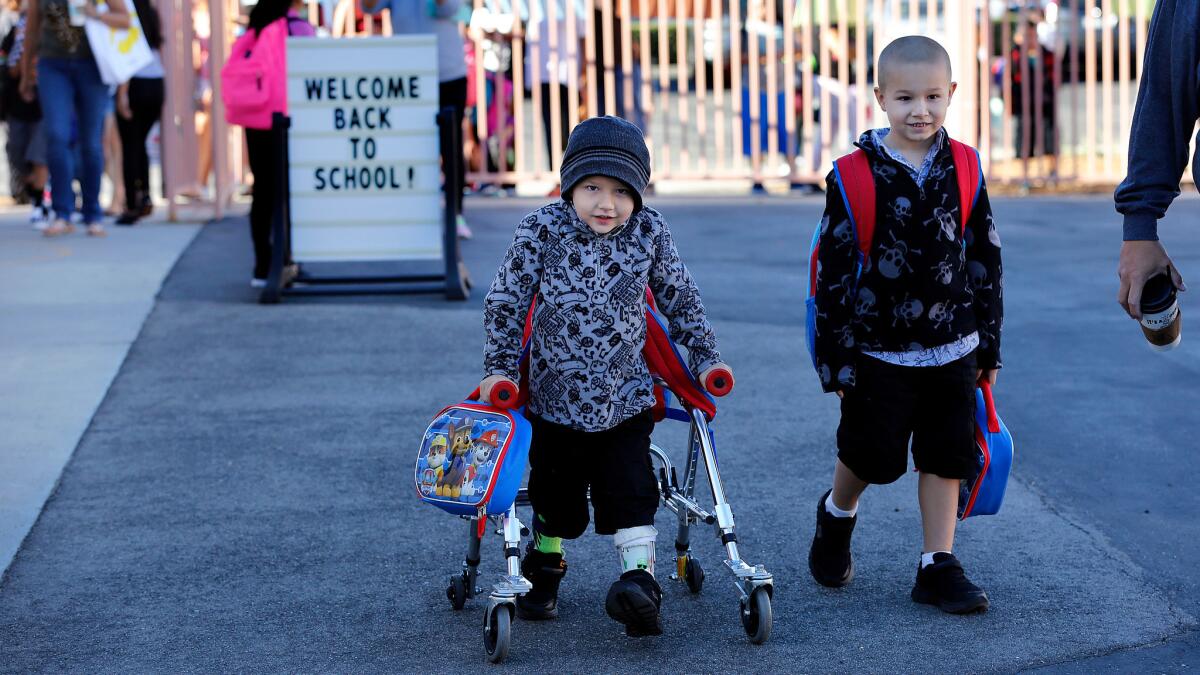
But walking from the minivan to the school — a taxing process of pulling his left leg with the right, today with the added weight of his bag and lunchbox — had tired him by 8 a.m.
In his new classroom, Lucian sat cross-legged at the edge of a colorful rug, his walker to his left. When his teacher took attendance, he turned around to grin at Israel, sitting in the back.
Israel got permission from the school to stay with Lucian on his first day, unsure if the boy would be able to manage on his own. When Erin left an hour prior, Lucian called after her, his eyes wide with panic.
Lucian’s teacher Taylor Severn began to teach the class a game: the kids dance to music and freeze when she shakes a tambourine.
“I’m going to stand up with my walker,” Lucian announced to the class.
The song started and Lucian gripped the handles of his walker, happily shaking his body and kicking his legs. He froze. He danced.
When Severn turned off the music, the students plopped to the floor.
Lucian pushed his walker back. He bent over and put his palms on the rug to slowly lower himself. He pulled his left leg over the right so he was sitting cross-legged. He clasped his hands together and fixed his eyes on his teacher.
At 10 a.m. recess, Israel decided to go home earlier than he’d planned, since Lucian seemed to be doing OK.
He watched his son pull a toy out of a bin on the yard, extending his arm as he tried to land a tethered ball into a cup. Kids around him hula-hooped and took turns on tricycles.
A boy asked Lucian about his walker, and he pointed to his left leg and sheepishly explained that his sister fell on it when they were playing.
Israel walked over to Lucian, who was now at a lunch table eating a Rice Krispie treat.
He kissed his son and headed to his car.
Lucian, talking to the girl across from him, didn’t turn around to watch him leave.
Twitter: @skarlamangla
To read the article in Spanish, click here
MORE NATIONAL NEWS
An outsider takes charge of the Border Patrol — and yes, he’ll wear the green uniform
Marijuana, assisted suicide, fracking — Colorado’s freewheeling initiative days may soon be over
It’s not easy living in a Trump building these days
DEA backs off a ban on kratom, a plant used to treat opioid addiction
More to Read
Sign up for Essential California
The most important California stories and recommendations in your inbox every morning.
You may occasionally receive promotional content from the Los Angeles Times.

